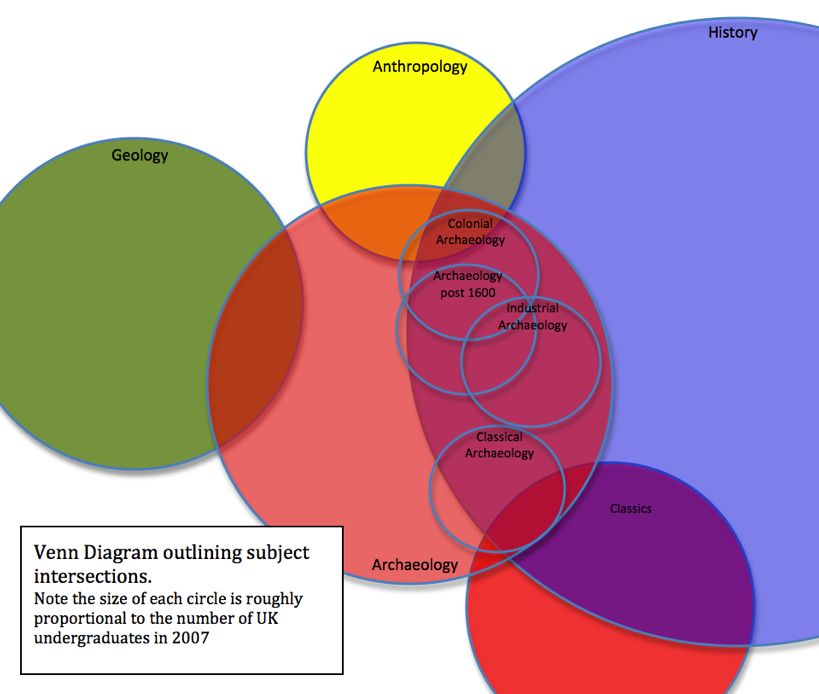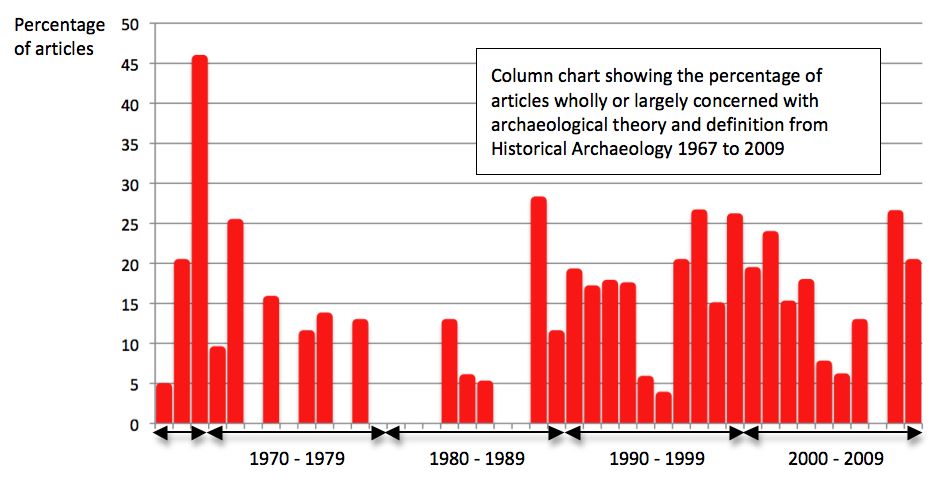Material prepared as part of Leicester University's M.A. Programme in Historical Archaeology
by Stephen Wass
Historical Archaeology is the most expensive way in the world to learn something we already know.’ Should historian Peter Sawyer’s dismissive comment be refuted? How? Or why not?
by Stephen Wass
Assigment
2.7 Interpreting Assemblages. Just 400 words were called for in this
assignment, but there was so much to say in just over 2,500 ....
Introduction
In November of 2010 I purchased a set of English Great Pipes from an individual in Bath; because of his personal circumstances he was unable to provide much information about the pipes except that they had not been played for around 8 years. The components of the pipes were supplied disassembled so the initial task was to examine each component in order to assess its function within the assemblage as a first step towards putting them once again in paying condition. (Fig.1)
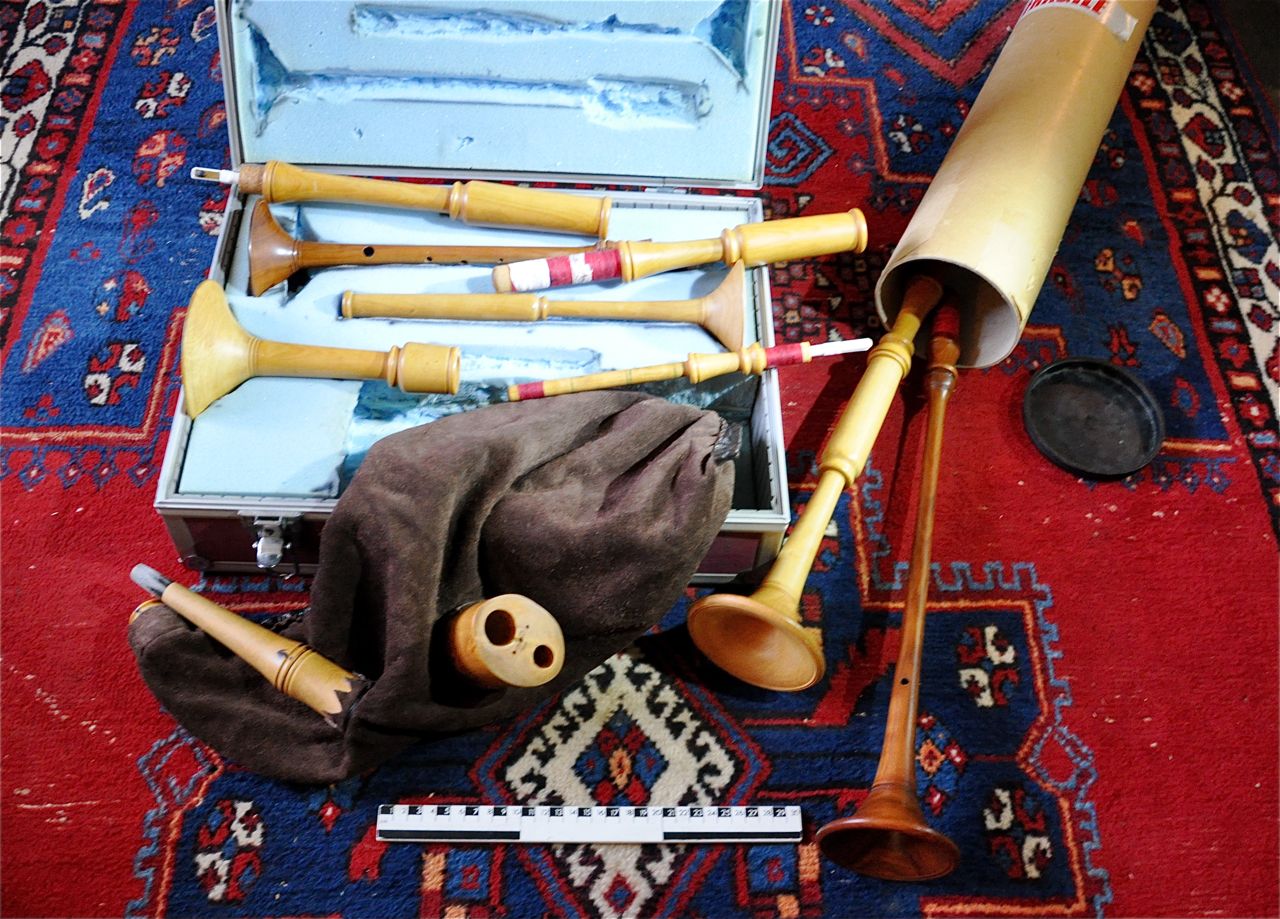
The essential structural elements of a set of bagpipes are the mouth piece, the bag, the chanter, and the drone or drones. The basic construction and relationships between these elements is explained in detail by Baines (1995: 12 - 23) but even a cursory inspection of the assemblage reveals a situation in which there seem to be more parts than necessary for a single set of pipes, a further reason for detailed study. Because sizing is a vital element in bagpipe construction and tuning a comprehensive set of measurements are included within the text. (See Appendix 1 for discussion of wood types.)
The Mouthpiece
This is cylindrically bored ( diameter 7mm ) with a tapering outline from 14mm exterior diameter at the top to 40 mm towards the base (Fig. 2). The diameter is further reduced to 28mm in order to slot into the socketed end of the stock. The upper end of the mouth piece is capped by a dark wood cylinder 35mm long. This has considerable wear as a result of being gripped in the musician’s mouth and brings the overall length of the piece to 185mm. The bottom end is closed by a circular brown leather pad supported by a thin metal rod inserted in to the base and bent at right angles. The assembly functions as a rudimentary valve to ensure that air is unable to leak from the bag
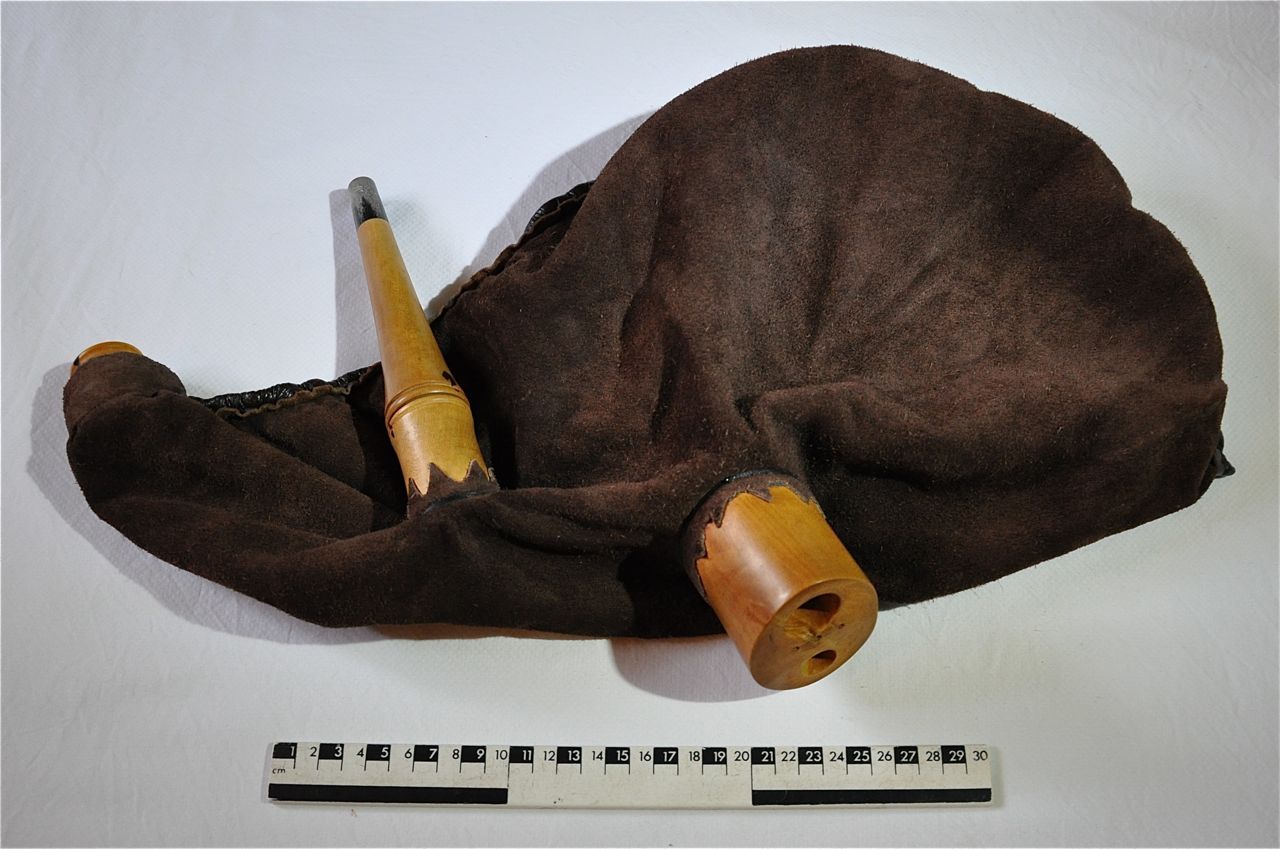
The Bag
The bag is made from a single heart shaped piece of leather which has been folded in half and seamed along the curving edge (Fig. 2). It appears that before finishing the sewn bag was turned inside out so as to leave the polished ( or outside) side on the inside and the soft (inside ) side outside, Three wooden socketed stocks have been incorporated into the bag. At the ‘neck’ or pointed end of the bag is the stock for the chanter with an external diameter of 36mm and a total length of 72mm of which just 20mm projects beyond the bag. Unlike the other stocks the joint with the leather appears to be a simple glued lap joint.
Approximately 150mm along the fold is the stock for the mouthpiece, the stock being 40mm in diameter and 64 mm long. The base is grooved to facilitate the fixing to the bag, in this case the hole in the leather has been given a serrated edge, folded out and then glued before being bound round with heavy gauge waxed thread which draws the leather into the groove mentioned earlier.
Finally the largest opening in the bag, 80mm beyond the mouthpiece is a double stock to accommodate two drones. This stock whilst joined to the leather in the same way as the one for the mouthpiece is roughly oval in section (major diameter 74 mm, minor diameter 57 mm. The stock which is 104mm long can be felt to taper within the bag possibly to avoid undue wear to the bag from sharp edges. The top face of the stock has three small screw holes at 10mm spacing which were presumably the point at which the wood would have been fastened to the faceplate of the lathe on which it was turned. In addition two larger holes have been bored, with diameters of 16mm and 2mm to act as sockets for the two drones. There is an oval stamp on the side of the stock which gives the maker’s name as Julian Goodacre and his place of work as Edinburgh.
The Chanters
The assemblage included two chanters with split stocks, these consist of additional socketed caps which fit over the reed and can be inserted into the stock mounted on the bag. This arrangement facilitates removal and replacement of the chanters without risking damage to the reed. Both stocks are conically bored. This is typical of western European folk instruments. Middle eastern and eastern European models tend to have a cylindrical bore. One of the advantages of a conical bore is that in skilled hands the reed can be overblown with additional pressure on the bag to extend the upper range of the instrument by 2 or 3 notes (Munrow 1976: 10).
The smaller of the two chanters (Fig.3) is pierced by a number of apertures. There are seven finger holes on the ‘front’ of the chanter and a single thumb hole at the back near the reed end. Numbering down from the reed end holes 1, 2 , 3, and 4 are single, hole 5 is double, hole 6 is single and hole 7 is double. The exact size and spacing vary
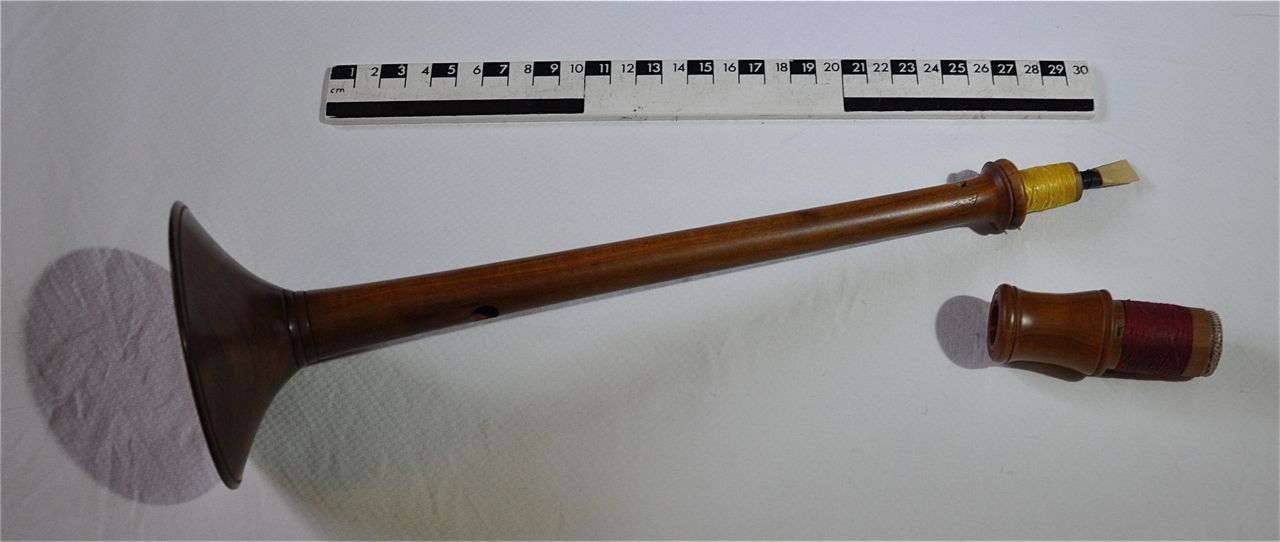
considerably presumably in order to obtain the optimum tunings for individual notes. Experimentation with a Korg C4 Chromatic tuner demonstrates that the key note on hole 6 is D. Fingering is shown in Fig 4
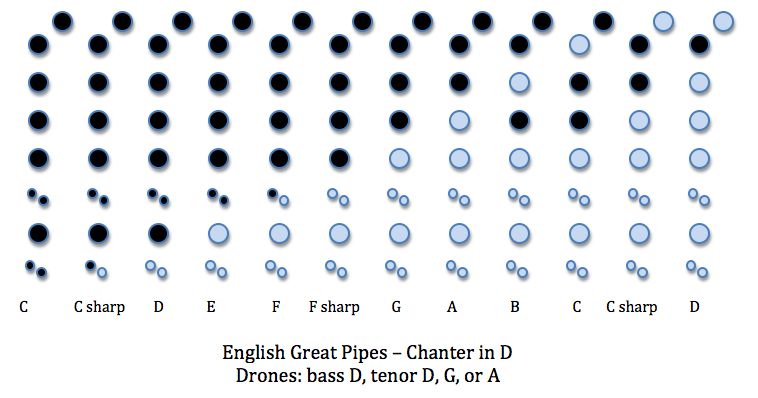
Use of the split finger holes and other alternate fingering means that the chanter can be played in the key of C as well as D. The top three holes have been partially filled with a wax-like substance and then redrilled, presumably as part of a tuning or retuning process. There is considerable wear to the wood’s finish around these upper three holes. 50mm below hole 7 are two opposed vent holes. As Baines says, ‘Their function is complex. Partly it is to equalize the tone of the lowest note with that of the others; partly it may be to permit a considerable extension of the tube length to serve the purpose of an acoustic resonator’ (Baines 1995: 19). Sometimes the vent holes may be partially blocked to facilitate the tuning of the lowest note but there is no trace of any such usage in this case. Curiously the ‘Goodacre’ maker’s mark is drilled through by the thumb hole but the place of origin is still able to be read as ‘Edinburgh’. The bore of this chanter begins at 6mm and widens through a length of 285 mm to bore of 16mm, beyond that point the chanter flares out to a flattened bell 95mm in diameter.
The reed is double and made out of cane, 11mm at its widest and tapering fairly sharply over 24mm to the point where it is bound by thread to the tube or staple which is inserted into the bore of the chanter. The protective element of the split stock fits over the reed and is closed at its top end by a coarse fabric mesh. The top end of the chanter and the stock are marked with what seems to be an indelible black marker pen as an aid to aligning the various components. This convenience is bought at the price of partially disfiguring a well made and expensive instrument. This feature is also present on the mouthpiece and the second chanter and suggests an unusually cavalier attitude to the instrument’s appearance.
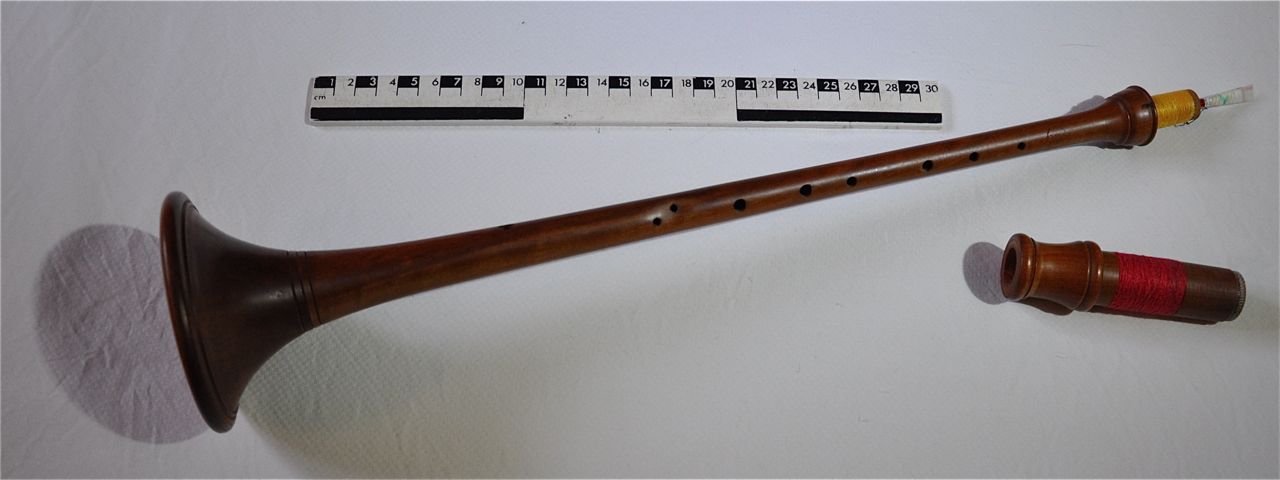
The larger of the two chanters is in many ways similar to the one described above (Fig. 5). Apart from its size the most obvious difference is the presence of a lower thumb hole between and behind holes 5 and 6. This is an alternative to the arrangement of double holes at 5 in G. Goodacre comments, ‘the second thumb hole is to play flattened third (i.e. B flat on G chanter). I only supply this for customers who ask for it’ (Goodacre 2010a). The key note is G. The fingering is shown in Fig. 6. The alternate fingering means that the chanter can play in the keys of G, C or F (Fig. 6). The bore varies from 6mm to 15mm over a length of 420mm and the final bell is 97mm in diameter. The reed in this case is made of plastic and is rather more slender being 9mm at its widest and 33mm in length. The chanter has a ‘Goodacre’ maker’s mark but this time the place of origin is marked as Peebles. It is also stamped with the number 53. Goodacre remarks, ‘the G chanter was made for Alan Cormack in January 1999. I don’t have any record of him having a high D chanter ‘ (Goodacre 2010a).

The Drones
Goodacre is clearly very proud of the drone on his sets of Great English Pipes, he says, ’The D drone is impressive. It is nearly four feet long, in four sections with a large, flared bell. It is tuned to D three octaves below the bottom D of the chanter, a wondrous low note’ (Goodacre 2010b). The base drone within the assemblage came in three sections. The top section including the bell appears to consist of two parts which have jammed at the joint and cannot at present be separated without risking some damage to the instrument. (Fig. 7)
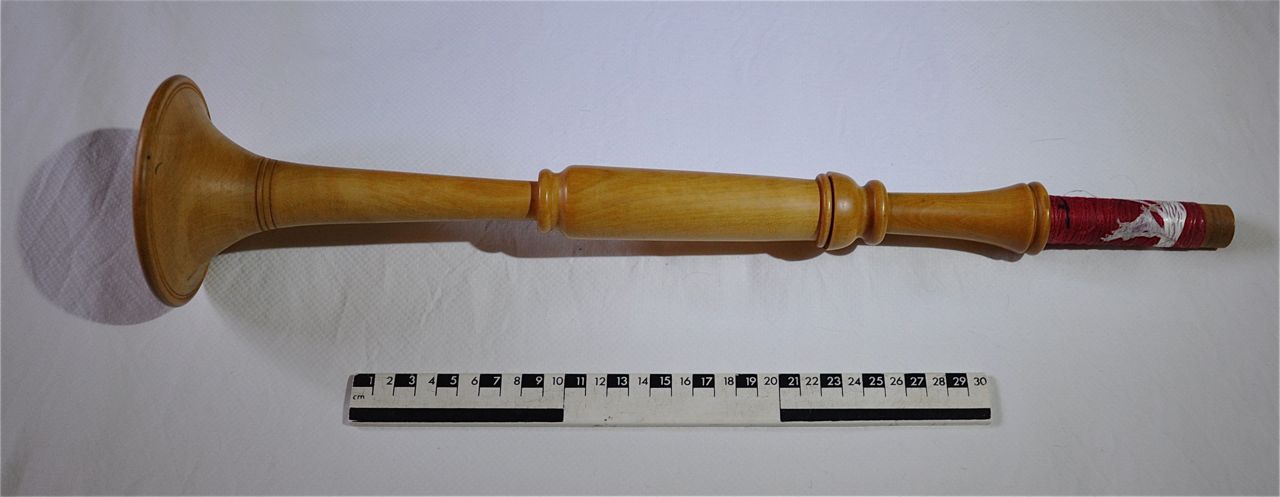
Fig. 7 Top two sections of bass drone
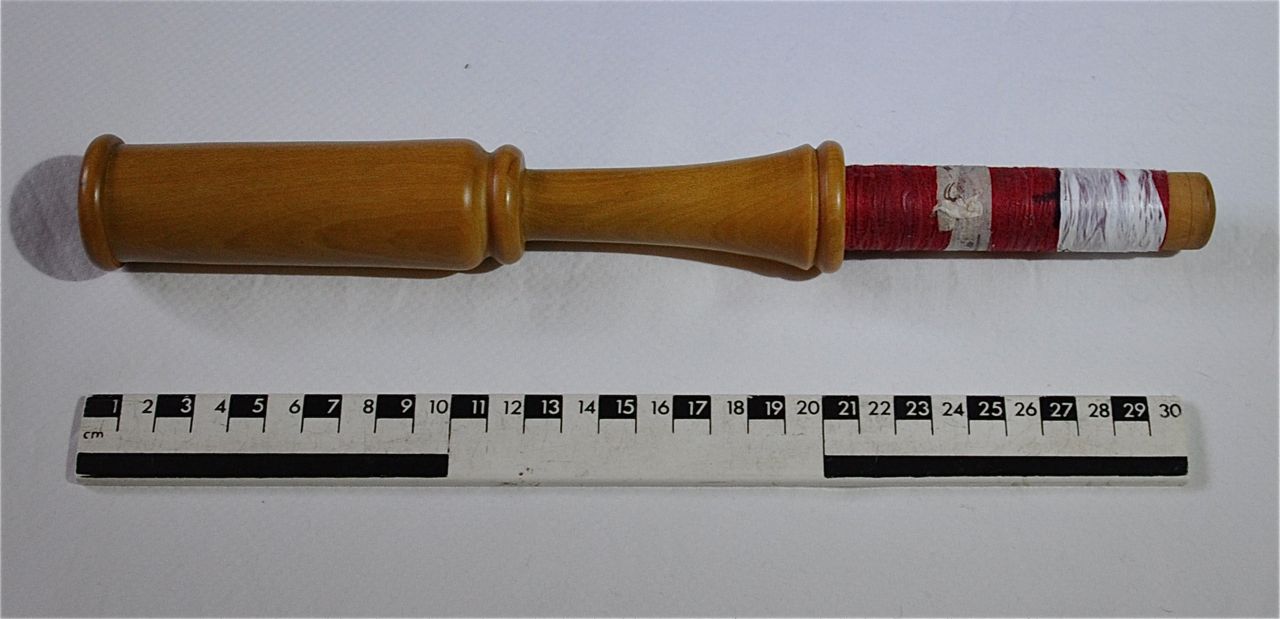
Fig. 8. Middle section of base drone
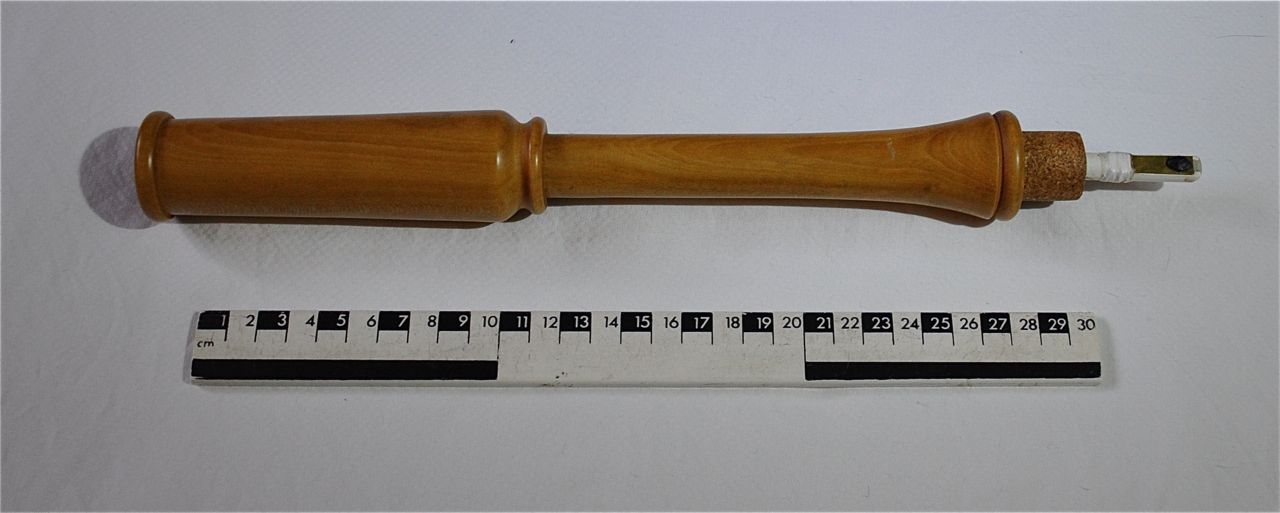
Fig. 9 The bottom section of the base drone with reed
The sections are drilled with a common cylindrical bore of 7mm. Decorative aspects of the turning (Figs. 7, 8 and 9 ) means that the outer diameter varies between 22mm and 38mm with the bell flaring out to 108 mm. There have clearly been issues with the binding on the joints as they all display a variety of different coloured threads: red, black and white, suggesting at least three phases of repair. Uniquely for the assemblage the joint which fits into the stock on the bag is lined with a layer of cork 1.5mm thick. The reed is a single brass strip 6mm wide and approximately 30 mm long which is bound across an opening in a white plastic tube 10mm in diameter and 57 mm long. This is wrapped with a white plastic tape to ensure a tight fit into the bore of the drone. There is an oval mounded deposit of a black wax-like material on the end of the brass reed presumably to correct or control the tuning (Fig. 9).
In addition there was a second bell section of similar proportions but with an even larger bell (fig. 10), 116mm in diameter. Presumably this can be fitted to the lower three sections to lower the tone to give a low G drone (see below)

The Tenor drone comes in two sections designed to slide over each other to facilitate changes in tuning. The common cylindrical bore is 5mm. The upper section is 320mm long including the bell which has a diameter of 87mm. The outer diameter varies between 15mm and 23mm. (fig. 11)
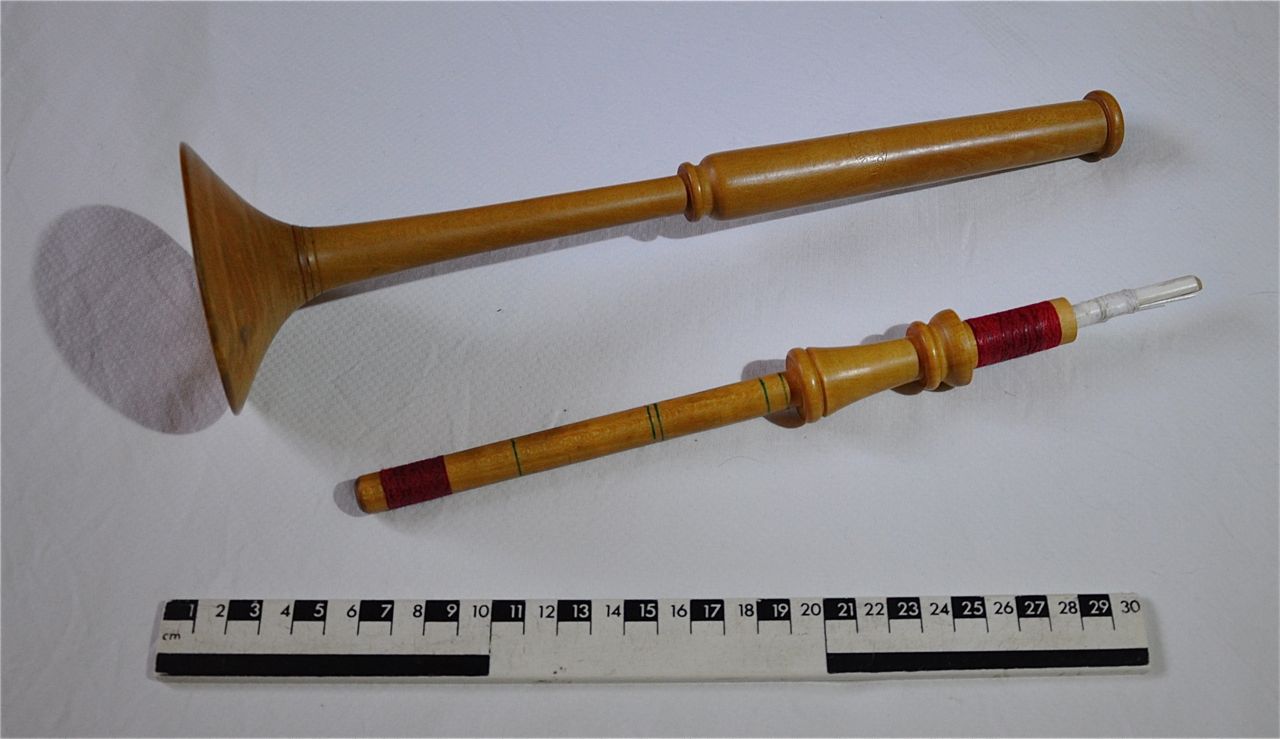
The lower section has a thin cylindrical section, 140mm long and 13mm in diameter which slides easily into the top part. This is roughly marked in green ink. The first mark towards the top end consists of a line around the pipe labeled with an ‘A’ below that by some 45mm are two lines 3mm apart with a capital ‘C’ underneath. Finally towards the bottom of the tube are two further lines 5mm apart but unlabelled. (see Fig. 11) These markings are clearly an aid to tuning. Testing shows that with the present settings the upper A sounds accurately and the middle two marks correspond with C and C sharp . The bottom two marks give E flat and below that D. This corresponds with Goodacre’s statement, ‘My preferred drone arrangement is a bass G with a tenor D that can be tuned down to C when playing in C’ (Goodacre 2010b). The reed is similar in construction to the one for the base drone but has a plastic tongue 4mm wide and approximately 36mm long fastened to a plastic tube which is 60mm long. This all fits into the second smaller socket on the stock attached to the bag.
Conclusion
Julian Goodacre set up as a bagpipe maker in Edinburgh in 1984 and moved his workshop to Peebles in 1990 (Goodacre 2000). Clearly the assemblage represents an original set of pipes made prior to 1990 in the key of D with additional components purchased in 1999 to allow for tunes in G to be played. Although the pipes are in good condition the untidy joint repairs and pen marks indicate a period when they clearly undervalued. An assembled version of the pipes, configured to pay in G with the bass drone tuned to D and the tenor drone to A is pictured below (Fig. 12)
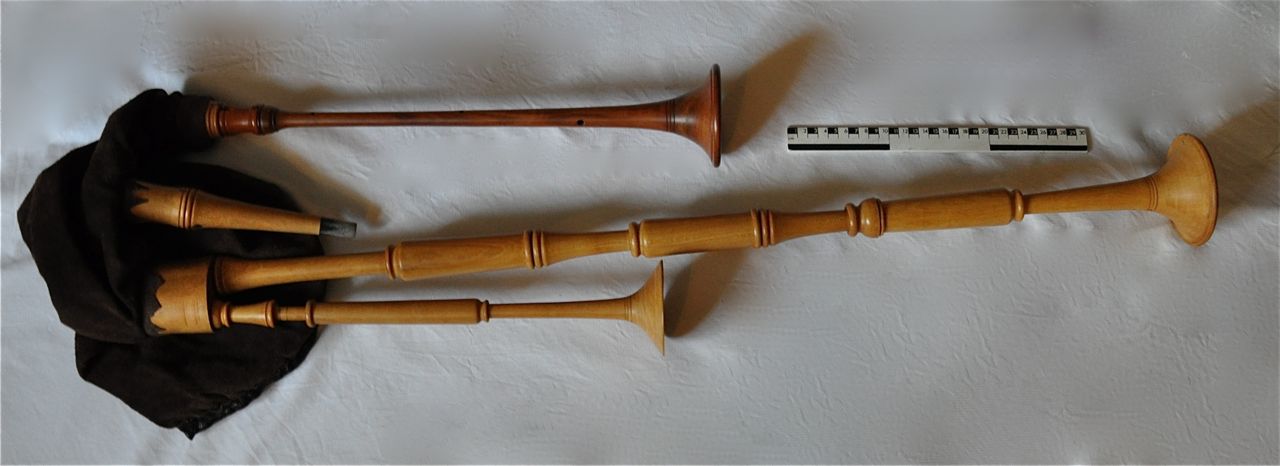
Fig.12 Full set of English Great Pipes set up to play in G
Clearly this is a thoroughly mechanistic approach to the assemblage which as a musical instrument should be studied within a much wider context: ‘several studies have used unusually broad ranges of data (historically, geographically and morphologically – i.e., museum and contemporary instruments, ceremonial and commercial instruments) in order comparatively to explore processes and systems of thinking, classifying and evaluating images and sound’ (Diamond, Cronk & Von Rosen 1994: 10). In addition Buchli reminds us that objectification either in written accounts or museum displays, ‘diminishes the sensual physicality of the object from three rich sensual ones to the two dimensions we typically encounter’ (Buchli 2004: 183 ). As a partial attempt to counter this and to reinvest the assemblage with some semblance of ‘life’ the pipes have been sent back to the maker to be overhauled with a view to playing them out in the summer.
Appendix 1. Woods Used.
Superficial visual examination by eye and with low power lens suggest that the bulk of the wood work is made from fruit wood, possibly apple or pear. The chanters are significantly darker and may be made from plum or cherry wood. Goodacre demonstrates remarkable concern for the material used in his pipes and the role they play in giving an instrument a history. To this end it is his usual practice to photograph and record individual trees felled and which specific pipes are manufactured from them (Goodacre 2010b).This information is then passed on to purchasers and other users. The forthcoming overhaul should result in a definitive statement as to the origins of the wood used in these pipes.
Bibliography
Baines, A. 1995 Bagpipes, Occasional papers on Technology, 9. Pitt Rivers Museum, University of Oxford
Buchli, V. 2004 ‘Material culture: current problems.’ In Meskell and R.W. Preucel A Companion to Social Archaeology, Oxford, Blackwell.
Diamond, B., Cronk, M.S., Von Rosen, F. 1994 Visions of Sound: musical instruments of First Nation communities in Northeastern America. University of Chicago Press.
Goodacre, J. 2000 CD Piper Calls Yer Tunes – sleeve notes, White House Musics WHCD03
Goodacre, J. 2010a Email received 25.11.2010
Goodacre, J. 2010b website http://www.goodbagpipes.com/goodbagpipes/english-bagpipes/english-great-pipe.html, accessed 9.12.2010
Munrow, D, 1976 Instruments of the Middle Ages and Renaissance, Oxford University Press
Assignment I. This is an expanded version of the paper as submitted with information about the methodology for constructing two charts and some further thoughts about the implications of Sawyer's words.
A Set of Julian Goodacre’s English Great Pipes
Introduction
In November of 2010 I purchased a set of English Great Pipes from an individual in Bath; because of his personal circumstances he was unable to provide much information about the pipes except that they had not been played for around 8 years. The components of the pipes were supplied disassembled so the initial task was to examine each component in order to assess its function within the assemblage as a first step towards putting them once again in paying condition. (Fig.1)

Fig1. Assemblage as first unpacked
The essential structural elements of a set of bagpipes are the mouth piece, the bag, the chanter, and the drone or drones. The basic construction and relationships between these elements is explained in detail by Baines (1995: 12 - 23) but even a cursory inspection of the assemblage reveals a situation in which there seem to be more parts than necessary for a single set of pipes, a further reason for detailed study. Because sizing is a vital element in bagpipe construction and tuning a comprehensive set of measurements are included within the text. (See Appendix 1 for discussion of wood types.)
The Mouthpiece
This is cylindrically bored ( diameter 7mm ) with a tapering outline from 14mm exterior diameter at the top to 40 mm towards the base (Fig. 2). The diameter is further reduced to 28mm in order to slot into the socketed end of the stock. The upper end of the mouth piece is capped by a dark wood cylinder 35mm long. This has considerable wear as a result of being gripped in the musician’s mouth and brings the overall length of the piece to 185mm. The bottom end is closed by a circular brown leather pad supported by a thin metal rod inserted in to the base and bent at right angles. The assembly functions as a rudimentary valve to ensure that air is unable to leak from the bag

Fig. 2 the bag with stock for chanter to left, mouthpiece and oval stock for drones to right
The Bag
The bag is made from a single heart shaped piece of leather which has been folded in half and seamed along the curving edge (Fig. 2). It appears that before finishing the sewn bag was turned inside out so as to leave the polished ( or outside) side on the inside and the soft (inside ) side outside, Three wooden socketed stocks have been incorporated into the bag. At the ‘neck’ or pointed end of the bag is the stock for the chanter with an external diameter of 36mm and a total length of 72mm of which just 20mm projects beyond the bag. Unlike the other stocks the joint with the leather appears to be a simple glued lap joint.
Approximately 150mm along the fold is the stock for the mouthpiece, the stock being 40mm in diameter and 64 mm long. The base is grooved to facilitate the fixing to the bag, in this case the hole in the leather has been given a serrated edge, folded out and then glued before being bound round with heavy gauge waxed thread which draws the leather into the groove mentioned earlier.
Finally the largest opening in the bag, 80mm beyond the mouthpiece is a double stock to accommodate two drones. This stock whilst joined to the leather in the same way as the one for the mouthpiece is roughly oval in section (major diameter 74 mm, minor diameter 57 mm. The stock which is 104mm long can be felt to taper within the bag possibly to avoid undue wear to the bag from sharp edges. The top face of the stock has three small screw holes at 10mm spacing which were presumably the point at which the wood would have been fastened to the faceplate of the lathe on which it was turned. In addition two larger holes have been bored, with diameters of 16mm and 2mm to act as sockets for the two drones. There is an oval stamp on the side of the stock which gives the maker’s name as Julian Goodacre and his place of work as Edinburgh.
The Chanters
The assemblage included two chanters with split stocks, these consist of additional socketed caps which fit over the reed and can be inserted into the stock mounted on the bag. This arrangement facilitates removal and replacement of the chanters without risking damage to the reed. Both stocks are conically bored. This is typical of western European folk instruments. Middle eastern and eastern European models tend to have a cylindrical bore. One of the advantages of a conical bore is that in skilled hands the reed can be overblown with additional pressure on the bag to extend the upper range of the instrument by 2 or 3 notes (Munrow 1976: 10).
The smaller of the two chanters (Fig.3) is pierced by a number of apertures. There are seven finger holes on the ‘front’ of the chanter and a single thumb hole at the back near the reed end. Numbering down from the reed end holes 1, 2 , 3, and 4 are single, hole 5 is double, hole 6 is single and hole 7 is double. The exact size and spacing vary

Fig. 3 D chanter with split stock opened to show reed
considerably presumably in order to obtain the optimum tunings for individual notes. Experimentation with a Korg C4 Chromatic tuner demonstrates that the key note on hole 6 is D. Fingering is shown in Fig 4

Fig 4. Fingering chart for D chanter
Use of the split finger holes and other alternate fingering means that the chanter can be played in the key of C as well as D. The top three holes have been partially filled with a wax-like substance and then redrilled, presumably as part of a tuning or retuning process. There is considerable wear to the wood’s finish around these upper three holes. 50mm below hole 7 are two opposed vent holes. As Baines says, ‘Their function is complex. Partly it is to equalize the tone of the lowest note with that of the others; partly it may be to permit a considerable extension of the tube length to serve the purpose of an acoustic resonator’ (Baines 1995: 19). Sometimes the vent holes may be partially blocked to facilitate the tuning of the lowest note but there is no trace of any such usage in this case. Curiously the ‘Goodacre’ maker’s mark is drilled through by the thumb hole but the place of origin is still able to be read as ‘Edinburgh’. The bore of this chanter begins at 6mm and widens through a length of 285 mm to bore of 16mm, beyond that point the chanter flares out to a flattened bell 95mm in diameter.
The reed is double and made out of cane, 11mm at its widest and tapering fairly sharply over 24mm to the point where it is bound by thread to the tube or staple which is inserted into the bore of the chanter. The protective element of the split stock fits over the reed and is closed at its top end by a coarse fabric mesh. The top end of the chanter and the stock are marked with what seems to be an indelible black marker pen as an aid to aligning the various components. This convenience is bought at the price of partially disfiguring a well made and expensive instrument. This feature is also present on the mouthpiece and the second chanter and suggests an unusually cavalier attitude to the instrument’s appearance.

Fig 5. Low G chanter with split stock opened to show reed
The larger of the two chanters is in many ways similar to the one described above (Fig. 5). Apart from its size the most obvious difference is the presence of a lower thumb hole between and behind holes 5 and 6. This is an alternative to the arrangement of double holes at 5 in G. Goodacre comments, ‘the second thumb hole is to play flattened third (i.e. B flat on G chanter). I only supply this for customers who ask for it’ (Goodacre 2010a). The key note is G. The fingering is shown in Fig. 6. The alternate fingering means that the chanter can play in the keys of G, C or F (Fig. 6). The bore varies from 6mm to 15mm over a length of 420mm and the final bell is 97mm in diameter. The reed in this case is made of plastic and is rather more slender being 9mm at its widest and 33mm in length. The chanter has a ‘Goodacre’ maker’s mark but this time the place of origin is marked as Peebles. It is also stamped with the number 53. Goodacre remarks, ‘the G chanter was made for Alan Cormack in January 1999. I don’t have any record of him having a high D chanter ‘ (Goodacre 2010a).

Fig 6. Fingering chart for low G chanter
The Drones
Goodacre is clearly very proud of the drone on his sets of Great English Pipes, he says, ’The D drone is impressive. It is nearly four feet long, in four sections with a large, flared bell. It is tuned to D three octaves below the bottom D of the chanter, a wondrous low note’ (Goodacre 2010b). The base drone within the assemblage came in three sections. The top section including the bell appears to consist of two parts which have jammed at the joint and cannot at present be separated without risking some damage to the instrument. (Fig. 7)

Fig. 7 Top two sections of bass drone

Fig. 8. Middle section of base drone

Fig. 9 The bottom section of the base drone with reed
The sections are drilled with a common cylindrical bore of 7mm. Decorative aspects of the turning (Figs. 7, 8 and 9 ) means that the outer diameter varies between 22mm and 38mm with the bell flaring out to 108 mm. There have clearly been issues with the binding on the joints as they all display a variety of different coloured threads: red, black and white, suggesting at least three phases of repair. Uniquely for the assemblage the joint which fits into the stock on the bag is lined with a layer of cork 1.5mm thick. The reed is a single brass strip 6mm wide and approximately 30 mm long which is bound across an opening in a white plastic tube 10mm in diameter and 57 mm long. This is wrapped with a white plastic tape to ensure a tight fit into the bore of the drone. There is an oval mounded deposit of a black wax-like material on the end of the brass reed presumably to correct or control the tuning (Fig. 9).
In addition there was a second bell section of similar proportions but with an even larger bell (fig. 10), 116mm in diameter. Presumably this can be fitted to the lower three sections to lower the tone to give a low G drone (see below)

Fig.10 Additional bell for base drone
The Tenor drone comes in two sections designed to slide over each other to facilitate changes in tuning. The common cylindrical bore is 5mm. The upper section is 320mm long including the bell which has a diameter of 87mm. The outer diameter varies between 15mm and 23mm. (fig. 11)

Fig. 11 the tenor drone disassembled
The lower section has a thin cylindrical section, 140mm long and 13mm in diameter which slides easily into the top part. This is roughly marked in green ink. The first mark towards the top end consists of a line around the pipe labeled with an ‘A’ below that by some 45mm are two lines 3mm apart with a capital ‘C’ underneath. Finally towards the bottom of the tube are two further lines 5mm apart but unlabelled. (see Fig. 11) These markings are clearly an aid to tuning. Testing shows that with the present settings the upper A sounds accurately and the middle two marks correspond with C and C sharp . The bottom two marks give E flat and below that D. This corresponds with Goodacre’s statement, ‘My preferred drone arrangement is a bass G with a tenor D that can be tuned down to C when playing in C’ (Goodacre 2010b). The reed is similar in construction to the one for the base drone but has a plastic tongue 4mm wide and approximately 36mm long fastened to a plastic tube which is 60mm long. This all fits into the second smaller socket on the stock attached to the bag.
Conclusion
Julian Goodacre set up as a bagpipe maker in Edinburgh in 1984 and moved his workshop to Peebles in 1990 (Goodacre 2000). Clearly the assemblage represents an original set of pipes made prior to 1990 in the key of D with additional components purchased in 1999 to allow for tunes in G to be played. Although the pipes are in good condition the untidy joint repairs and pen marks indicate a period when they clearly undervalued. An assembled version of the pipes, configured to pay in G with the bass drone tuned to D and the tenor drone to A is pictured below (Fig. 12)

Fig.12 Full set of English Great Pipes set up to play in G
Clearly this is a thoroughly mechanistic approach to the assemblage which as a musical instrument should be studied within a much wider context: ‘several studies have used unusually broad ranges of data (historically, geographically and morphologically – i.e., museum and contemporary instruments, ceremonial and commercial instruments) in order comparatively to explore processes and systems of thinking, classifying and evaluating images and sound’ (Diamond, Cronk & Von Rosen 1994: 10). In addition Buchli reminds us that objectification either in written accounts or museum displays, ‘diminishes the sensual physicality of the object from three rich sensual ones to the two dimensions we typically encounter’ (Buchli 2004: 183 ). As a partial attempt to counter this and to reinvest the assemblage with some semblance of ‘life’ the pipes have been sent back to the maker to be overhauled with a view to playing them out in the summer.
Appendix 1. Woods Used.
Superficial visual examination by eye and with low power lens suggest that the bulk of the wood work is made from fruit wood, possibly apple or pear. The chanters are significantly darker and may be made from plum or cherry wood. Goodacre demonstrates remarkable concern for the material used in his pipes and the role they play in giving an instrument a history. To this end it is his usual practice to photograph and record individual trees felled and which specific pipes are manufactured from them (Goodacre 2010b).This information is then passed on to purchasers and other users. The forthcoming overhaul should result in a definitive statement as to the origins of the wood used in these pipes.
Bibliography
Baines, A. 1995 Bagpipes, Occasional papers on Technology, 9. Pitt Rivers Museum, University of Oxford
Buchli, V. 2004 ‘Material culture: current problems.’ In Meskell and R.W. Preucel A Companion to Social Archaeology, Oxford, Blackwell.
Diamond, B., Cronk, M.S., Von Rosen, F. 1994 Visions of Sound: musical instruments of First Nation communities in Northeastern America. University of Chicago Press.
Goodacre, J. 2000 CD Piper Calls Yer Tunes – sleeve notes, White House Musics WHCD03
Goodacre, J. 2010a Email received 25.11.2010
Goodacre, J. 2010b website http://www.goodbagpipes.com/goodbagpipes/english-bagpipes/english-great-pipe.html, accessed 9.12.2010
Munrow, D, 1976 Instruments of the Middle Ages and Renaissance, Oxford University Press
Assignment I. This is an expanded version of the paper as submitted with information about the methodology for constructing two charts and some further thoughts about the implications of Sawyer's words.
Historical Archaeology is the most expensive way in the world to learn something we already know.’ Should historian Peter Sawyer’s dismissive comment be refuted? How? Or why not?
